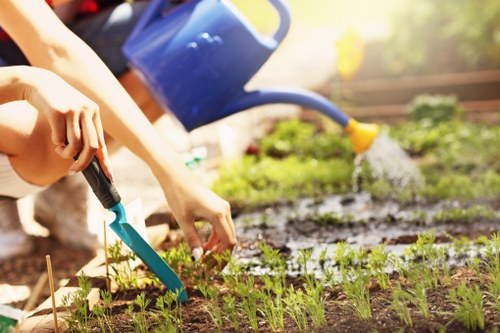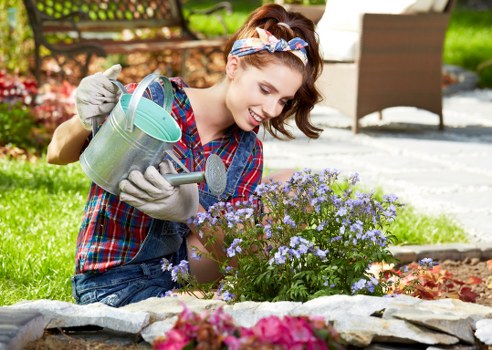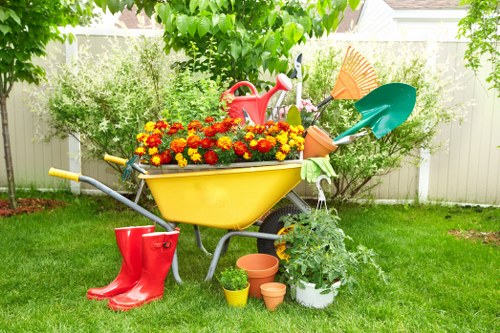Garden Fence Replacement: Enhancing Your Outdoor Space with a Local Gardener

Maintaining a beautiful and functional garden often involves several elements, one of the most important being the garden fence. Whether you're looking to replace an old fence or install a new one, partnering with a local gardener can offer numerous benefits. In this comprehensive guide, we'll explore the essentials of garden fence replacement, the advantages of working with local professionals, and tips to ensure you achieve the perfect boundary for your outdoor oasis.
Garden fences not only provide structural boundaries but also contribute significantly to the aesthetic appeal of your property. They offer privacy, security, and can even serve as a canvas for creative landscaping ideas. However, over time, fences can wear out due to weather conditions, pests, or general wear and tear. Recognizing when it's time for a replacement and understanding the process can save you time and resources in the long run.
When considering a garden fence replacement, it's essential to evaluate the condition of your current fence, understand your specific needs, and choose materials that align with your garden's style and functionality. Local gardeners are well-versed in the unique challenges and opportunities presented by your area's climate and soil conditions, making them invaluable partners in this endeavor.
The Importance of a Quality Garden Fence

A garden fence serves multiple purposes, from delineating property lines to providing a safe space for children and pets to play. A well-chosen fence can enhance the overall look of your garden, complementing plants, pathways, and other landscape features. Moreover, it can offer protection against intruders, reduce noise pollution, and even improve energy efficiency by acting as a windbreak.
When selecting a fence, consider factors such as height, material, maintenance requirements, and how it fits with your garden's existing design. For instance, a wrought iron fence may offer a classic and elegant look, while a wooden picket fence provides a more rustic and welcoming feel. The right choice depends on your personal preferences, budget, and the specific requirements of your outdoor space.
It's also crucial to think about the long-term durability of the materials you choose. Opting for high-quality, weather-resistant materials can save you from frequent repairs or replacements, ensuring that your garden remains both beautiful and functional for years to come.
Benefits of Hiring a Local Gardener for Fence Replacement

Partnering with a local gardener for your garden fence replacement offers several advantages. Local professionals possess in-depth knowledge of the area's climate, soil conditions, and prevalent pests, enabling them to recommend the best materials and designs suited for your specific environment. Their expertise ensures that your fence not only looks great but also stands the test of time.
Additionally, local gardeners often have established relationships with suppliers, allowing them to source quality materials at competitive prices. This can result in cost savings for you without compromising on the fence's integrity or appearance. Furthermore, hiring someone from your community fosters trust and accountability, as local professionals are more likely to be invested in maintaining a good reputation among their neighbors.
Another significant benefit is the personalized service you receive. Local gardeners can offer tailored solutions that align with your vision and the unique characteristics of your garden. From customized designs to flexible scheduling, working with a local expert ensures a smoother and more satisfying experience.
Steps to a Successful Garden Fence Replacement

Replacing a garden fence involves several key steps to ensure the project is completed efficiently and effectively. Here's a step-by-step guide to help you navigate the process:
- Assessment: Begin by evaluating the current fence's condition. Identify any damaged sections, and determine whether a full replacement is necessary or if certain parts can be repaired.
- Planning: Define the purpose of the new fence. Are you seeking more privacy, better security, or simply an aesthetic upgrade? Your goals will influence the design and materials chosen.
- Design Selection: Choose a design that complements your garden's style. Consider factors like height, color, and material. Sketching a rough layout can help visualize the final outcome.
- Material Selection: Based on your budget and preferences, select materials that offer durability and low maintenance. Common options include wood, vinyl, metal, and composite materials.
- Permits and Regulations: Check with local authorities to ensure compliance with any zoning laws or permits required for fence installation or replacement.
- Installation: Whether you choose to DIY or hire a professional, ensure that the installation is done correctly. Proper post setting, level alignment, and secure fastening are crucial for a long-lasting fence.
- Maintenance: Regular maintenance can extend the lifespan of your fence. This includes painting or staining, checking for and repairing damages, and cleaning as needed.
Choosing the Right Materials for Your Garden Fence

The material you select for your garden fence plays a pivotal role in its appearance, durability, and maintenance requirements. Here are some popular options to consider:
- Wood: Wood fences offer a classic and versatile look. They are available in various styles, such as picket, lattice, and privacy fences. While wood requires regular maintenance to prevent rot and weather damage, it can be stained or painted to match your garden's color scheme.
- Vinyl: Vinyl fences are known for their durability and low maintenance. They resist fading, cracking, and warping, making them an excellent choice for those seeking a long-lasting solution. Vinyl is available in multiple colors and styles, allowing for customization.
- Metal: Metal fences, including aluminum and wrought iron, provide a sturdy and elegant option. They are highly durable and require minimal maintenance. Metal fences can also be designed with intricate patterns, adding a decorative element to your garden.
- Composite: Composite fences combine the aesthetics of wood with the durability of synthetic materials. They are resistant to rot, pests, and weather damage, offering a maintenance-free alternative. Composite fences are available in various textures and colors, mimicking natural wood.
- Chain-Link: While not as decorative as other options, chain-link fences are cost-effective and highly durable. They offer good security and are suitable for areas where visibility is desired, such as around gardens or pools.
Design Ideas to Complement Your Garden
A well-designed fence can enhance the overall beauty of your garden. Here are some design ideas to inspire your fence replacement project:
- Natural Integration: Use materials that blend seamlessly with your garden, such as wooden panels or living fences with climbing plants like ivy or roses.
- Modern Minimalism: Choose clean lines and simple designs with materials like metal or composite for a sleek and contemporary look.
- Rustic Charm: Incorporate reclaimed wood or distressed finishes to add a rustic and charming appeal to your outdoor space.
- Ornamental Features: Add decorative elements like finials, post caps, or patterned panels to make your fence a standout feature.
- Color Coordination: Paint your fence in colors that complement your garden's palette, creating a harmonious and inviting atmosphere.
By considering these design elements, you can create a fence that not only serves its functional purpose but also enhances the aesthetic appeal of your garden.
Cost Considerations for Fence Replacement
Budgeting is a crucial aspect of any garden fence replacement project. Several factors influence the overall cost, including material selection, fence height, length, labor, and additional features. Here's a breakdown to help you estimate expenses:
- Material Costs: Prices vary widely depending on the material. Wood tends to be more affordable, while metal and composite materials can be pricier but offer greater durability.
- Height and Length: Taller and longer fences require more materials and labor, increasing the overall cost.
- Labor Fees: Hiring a local gardener or professional installer may incur labor charges. Getting multiple quotes can help you find the best value.
- Permits: Some regions require permits for fence installation or replacement, adding to the expense.
- Customization: Features like decorative panels, gates, or ornamental designs will increase the cost but add unique value to your fence.
To manage costs effectively, prioritize your needs, choose materials that offer the best balance between price and durability, and plan for any additional features you desire.
Maintenance Tips for Longevity
Proper maintenance can significantly extend the life of your garden fence. Here are some essential tips to ensure your fence remains in excellent condition:
- Regular Cleaning: Remove dirt, debris, and organic matter to prevent rot and decay. For wooden fences, power washing can be an effective method.
- Periodic Inspections: Check for signs of damage, such as loose boards, rust, or insect infestation. Addressing issues promptly can prevent further deterioration.
- Painting or Staining: Applying a fresh coat of paint or stain protects wooden fences from moisture and UV damage. It also allows you to refresh the fence's appearance.
- Repairs: Replace or repair damaged sections to maintain the fence's structural integrity and appearance.
- Vegetation Management: Trim plants and vines growing near or on the fence to prevent damage and maintain visibility.
By adhering to these maintenance practices, you can ensure that your garden fence remains functional and aesthetically pleasing for years to come.
Environmental Considerations
Choosing environmentally friendly materials and practices for your garden fence replacement can benefit both your garden and the planet. Here are some considerations:
- Sustainable Materials: Opt for materials like reclaimed wood, bamboo, or recycled composites that have a lower environmental impact.
- Eco-Friendly Treatments: Use non-toxic stains and paints to minimize chemical runoff and protect local wildlife.
- Local Sourcing: Purchasing materials from local suppliers reduces transportation emissions and supports the local economy.
- Durability: Selecting long-lasting materials reduces the need for frequent replacements, conserving resources and reducing waste.
- Green Practices: Implement sustainable installation practices, such as minimizing soil disturbance and preserving existing vegetation.
Incorporating these environmental considerations into your fence replacement project promotes sustainability and contributes to a healthier ecosystem.
Enhancing Security with Your Garden Fence
A secure garden fence provides peace of mind by deterring intruders and protecting valuable assets. Here are some strategies to enhance your fence's security:
- Height: Taller fences are more effective at preventing unauthorized access. Consider heights that comply with local regulations while providing adequate security.
- Material Strength: Choose robust materials like steel or reinforced wood that are difficult to breach or tamper with.
- Lockable Gates: Ensure that all gates have secure, lockable mechanisms to control access points.
- Visibility: Avoid designs with large gaps that can provide hiding spots. Solid or closely spaced panels enhance security.
- Lighting: Installing motion-sensor lights along your fence can deter potential intruders and improve visibility at night.
By implementing these security measures, your garden fence will serve as a reliable barrier, safeguarding your property and ensuring a safe environment.
Integrating Aesthetics and Functionality
Balancing aesthetics and functionality is key to creating a garden fence that not only serves its purpose but also enhances the beauty of your outdoor space. Here are some tips to achieve this balance:
- Design Harmony: Select a fence design that complements your garden's overall style, whether it's modern, traditional, rustic, or eclectic.
- Color Coordination: Choose colors that blend with your garden's color palette, plants, and architectural elements.
- Functional Features: Incorporate elements like built-in planters, trellises for climbing plants, or integrated benches to add functionality and visual interest.
- Natural Elements: Use natural materials and incorporate greenery to create a seamless transition between the fence and the garden.
- Personal Touches: Add decorative accents such as mosaic tiles, ornamental caps, or artistic panels to personalize your fence.
By thoughtfully integrating these elements, you can create a garden fence that is both practical and visually appealing, enhancing the overall appeal of your outdoor living space.
Local Regulations and Permits
Before embarking on a garden fence replacement project, it's essential to be aware of local regulations and permit requirements. Compliance ensures that your fence meets safety standards and avoids potential legal issues. Here's what you need to consider:
- Height Restrictions: Many municipalities have specific height limits for fences, especially near property lines or public spaces.
- Material Restrictions: Certain areas may prohibit specific materials, such as chain-link or metal fences, to maintain neighborhood aesthetics.
- Setback Requirements: Regulations often dictate how far a fence must be from property lines, sidewalks, or streets.
- Permits: Depending on the project's scope, you may need a building permit. Check with your local building department to understand the requirements.
- Homeowners Association (HOA) Rules: If you live in a community governed by an HOA, you'll need to adhere to their guidelines regarding fence styles, colors, and heights.
Consulting with a local gardener or fencing professional can help you navigate these regulations, ensuring a smooth and compliant installation process.
Choosing the Right Local Gardener for Your Project
Selecting the right local gardener to handle your garden fence replacement is crucial for achieving the desired results. Here are some factors to consider when making your choice:
- Experience: Look for professionals with a proven track record in fence installation and replacement. Experienced gardeners are more likely to handle challenges effectively.
- Portfolio: Review their previous projects to assess their workmanship and design capabilities. A diverse portfolio indicates versatility and creativity.
- References: Ask for references or read reviews from past clients to gauge their reliability and customer satisfaction.
- Licensing and Insurance: Ensure that the gardener is properly licensed and insured to protect against potential liabilities.
- Communication: Effective communication is essential for understanding your needs and ensuring that the project aligns with your vision.
- Cost Transparency: Choose a professional who provides clear and detailed estimates, avoiding hidden costs and ensuring budget adherence.
By carefully evaluating these factors, you can select a local gardener who will deliver a high-quality garden fence replacement that meets your expectations.
Sustainability in Fence Replacement
Embracing sustainability in your garden fence replacement project benefits both the environment and your garden. Here are ways to incorporate sustainable practices:
- Recycled Materials: Use materials made from recycled content, such as composite fencing, which reduces waste and conserves natural resources.
- Durable Design: Opt for designs and materials that offer longevity, minimizing the need for frequent replacements.
- Local Sourcing: Purchasing materials locally reduces transportation emissions and supports the local economy.
- Eco-Friendly Finishes: Choose stains, paints, and sealants that are low in volatile organic compounds (VOCs) to reduce pollution.
- Permaculture Principles: Integrate natural elements and plant life into your fence design, promoting biodiversity and ecological balance.
Implementing these sustainable strategies ensures that your garden fence replacement contributes positively to the environment while enhancing your outdoor space.
Innovative Fence Technologies
Advancements in fence technologies offer innovative solutions for garden fence replacement, enhancing functionality and aesthetics. Here are some cutting-edge options to consider:
- Smart Fencing: Incorporate technology like motion sensors, automated gates, and lighting systems that can be controlled remotely for added security and convenience.
- Modular Designs: Choose modular fencing systems that allow for easy customization, expansion, and reconfiguration as your garden evolves.
- Green Walls: Integrate living walls or vertical gardens into your fence design, promoting air purification and adding vibrant greenery.
- Composite Innovations: Explore composite materials that mimic natural wood textures while offering superior durability and low maintenance.
- Soundproof Fencing: Opt for fences designed to reduce noise pollution, creating a tranquil and peaceful garden environment.
Embracing these innovative technologies can elevate your garden fence, making it a functional and stylish centerpiece of your outdoor space.
Final Thoughts on Garden Fence Replacement
Replacing your garden fence is a significant investment that can transform your outdoor space, enhancing both its beauty and functionality. By partnering with a local gardener, you gain access to personalized service, expert knowledge, and quality craftsmanship tailored to your specific needs.
From selecting the right materials and design to ensuring compliance with local regulations and maintaining your fence's longevity, careful planning and execution are essential. Incorporating sustainable practices and innovative technologies can further elevate your garden, making it a harmonious and inviting retreat.
Don't wait to enhance your garden's appeal and functionality. Contact us today to begin your journey towards a stunning and enduring garden fence replacement that perfectly complements your outdoor sanctuary.
Book your service now and let our team of experienced local gardeners assist you in creating the perfect boundary for your garden, ensuring it remains a beautiful and secure space for years to come.